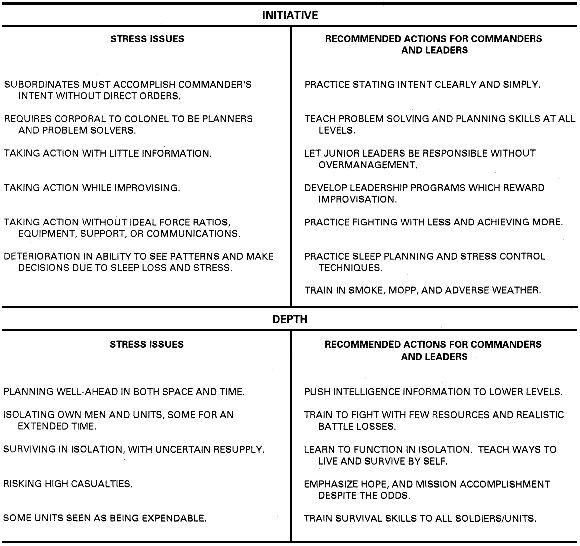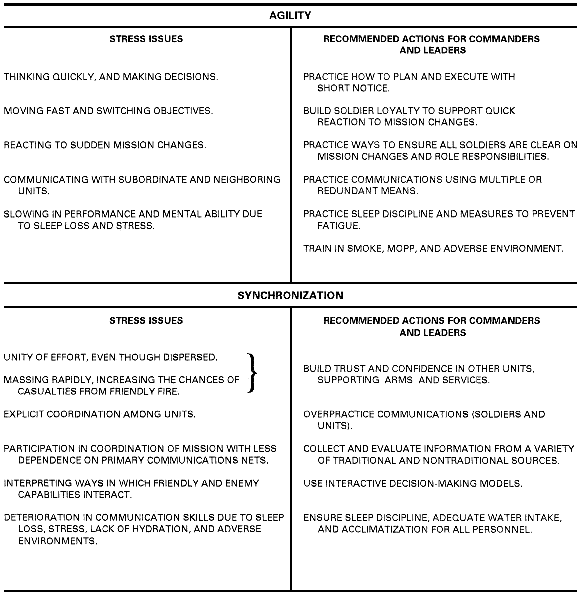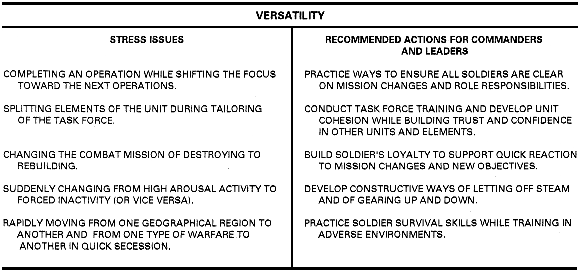| Patriot Outreach Supporting all Military Service Men, Women, Retirees, Veterans, Government Civilians, Battlefield Contractors and their Families. |
| Home | My Story | Get Help | What's Happening | About Stress & PTSD | News & Reports | Donate | Mission | Contact |
FM 22-51
LEADERS' MANUAL FOR COMBAT STRESS CONTROL
CHAPTER 7
STRESS ISSUES IN ARMY OPERATIONS
7-1. Introduction
This chapter reviews Army operational concepts for how we will fight. It highlights specific
stressors that can contribute to decreased effectiveness, battle fatigue casualties, or misconduct
stress behaviors. The chapter summarizes a number of other doctrinal manuals. For those readers
who are already familiar with those manuals, it will highlight stress issues which were not
explicitly stated in the original sources. For those readers who are not familiar with the source
manuals, this chapter provides a hasty "one-stop" reference source. However, they are strongly
encouraged to continue their education in the original references. All leaders must understand
these operational realities and the words used to describe them. Leaders at all levels work closely
with each other so they may be able to anticipate the stressors and prevent stress casualties.
7-2. Overview of the Challenges
a. Army Missions. Army forces must meet worldwide strategic challenges against the full
range of threats within highly varied operational theaters. In areas of greatest strategic
concern, the Army must be prepared to fight battles of unprecedented scope and intensity.
The operations surrounding such battles will routinely involve cooperation with other
services and allies. While the threat of tactical nuclear war has decreased, it may be
present in some confrontations. The threat of functioning on a chemical or biological
battlefield remains a possibility in any conflict, anywhere in the world.NOTE
Every scenario involves its own unique combination of stressors which must be
controlled to assure that our forces function at their best.
b. Joint and Combined Operations. The nature of modern battle and the broad dispersion
of US geographical interests require joint operations by US forces. It is imperative that
Army units fight as part of a joint team with units of the US Air Force, the US Navy, and
the US Marine Corps. We must cooperate with representatives of civilian and
government agencies. These agencies may include the State Department, Central
Intelligence Agency, Federal Bureau of Investigation, Red Cross, United Nations, and
international relief agencies. It is also critical that commanders prepare themselves and
their troops to fight in coalition/ combined warfare alongside the forces of our nation's
allies. Teamwork in joint and combined operations will be necessary in any battle the
Army forces fight, as well as in operations other than war.(1) Leaders must take active steps to counteract prejudices, disrespect, mistrust,
and doubt about the reliability and competence of other services and allies. It is
extremely important that soldiers respect those beliefs that are different from our
own and respect the customs and practices of people in other nations. Unchecked
prejudices, disrespect, mistrust, and doubt can lead to high battle fatigue
casualties or to misconduct stress behaviors which could damage the coalition.
(2) When directed by the national command authority (NCA), the Army may need
to assist a less-developed host nation (HN) in setting up an effective stress control
or community mental health/social services system. This system may be for its
Armed Forces, refugees, and/or civilian population.c. Forward Presence Versus Contingency Operations. Army operations in the foreseeable
future will be fought in one of two basic environments.(1) One environment may be an anticipated theater of war with an existing
support structure of communications, air defense, logistic facilities, and ports.
Service families may be present in the theater before the conflict. Their presence
adds additional concern for their security and for noncombatant evacuation
operations. The troops and their families must have confidence that the chain of
command can be trusted to implement a workable plan to assure the safety of the
families. Otherwise, the soldiers' first concern will be the safety of their family
rather than mission accomplishment.
(2) The other environment may be a relatively austere theater. In this
environment, Army leaders will have to choose between creating such a support
base or fighting with only external support. Contingency operations are military
actions requiring rapid deployment in response to a crisis. Contingency operations
involving Army forces may provide a rapid show of force in support of a
threatened ally to deter aggression by a hostile neighbor. Contingency operations
react to the invasion of a friendly government, protect lives and property of US
nationals, rescue hostages, or perform other tasks as directed by the NCA. The
size of a contingency force, its mission, and its area of operations will vary.(a) Rapid deployment itself involves much physical and mental stress
during preparation and transportation. If the deployment crosses many
time zones, there is the added disruption of the body's biological daynight/
workrest cycles.(b) The necessity for secrecy in contingency operations puts great stress
on the soldiers who are suddenly "sealed in." Great stress is also placed on
their families with whom they cannot communicate. Leadership must
ensure and support the establishment of family support groups. They must
also be sensitive to the needs of families to learn about the involvement of
their spouses in particular military operations. Stress control leader actions
are discussed in Appendix A.d. Austere Support. Army forces must be prepared to fight their battles at the end of long,
vulnerable lines of logistical support, with limited availability of airlift and sealift. They
must anticipate high consumption rates for all supplies. They may have to fight
outnumbered against an enemy with significantly shorter supply lines. This may be true
for leading US echelons even in a contingency operation against a distant opponent much
smaller than the United States. Logistical support may be austere in such situations and
thereby markedly affect the design of campaigns and the planning and conduct of battles.
NOTE
Shortages and uncertainties of resupply contribute to low morale and high rates of battle
fatigue casualties unless troops are psychologically prepared to improvise. Once apprised
of the situation, they must believe that everything feasible is being done to support them.e. Urban Combat. Combat in built-up areas will be unavoidable in war and operations
other than war (conflict). Units will have to plan for attack and defense in urban areas and
for fluid battles around them. The usual static, house-to-house nature of urban warfare,
with many snipers, mines, and booby traps, tends to increase battle fatigue casualties
unless troops are well-trained and led. Built-up areas are also likely to provide
temptations for looting, alcohol and substance abuse, black marketeering, and harmful
social interactions. Preventive measures must be in place to avoid these temptations. For
more detailed information, refer to FMs 90-10 and 90-10-1.
f. Presence of Civilians and Rules of Engagement. The likely presence of civilians in
combat areas can have diverse effects. Seeing and perhaps accidentally inflicting
casualties on civilians (especially if they are women and children) increases battle
fatigue, especially if the civilians are perceived as friendly. If the civilians are hostile, or
have been infiltrated by enemy partisans, the potential for misconduct stress behaviors is
high unless strong unit cohesion and a sense of ethical purpose protects against it.
g. Continuous Operations. Continuous land combat is an advanced warfare concept made
possible by the almost complete mechanization of land combat forces. It is also made
possible by the technology that permits effective movement and target detection at night,
in poor weather, and in other low-visibility conditions. Combat can continue around the
clock at the same high level of intensity for extended periods. Armies now have the
potential to fight without letup. The reasons that have traditionally forced a pause --
darkness, resupply, regrouping -- have been largely overcome by technological advances.
Thus, CONOPS is more possible due to advanced technology, and the demands of such
operations are very stressful. However, the possibility of failure of the sophisticated
devices can also be a great stressor. Soldiers who become dependent on the technology in
their military occupational specialty could feel extremely vulnerable should the
equipment fail. Where possible, soldiers should be taught how to accomplish the task
without the device so that its failure would not be so catastrophic. Refer to FM 25-101 for
doctrine on battle-focused training. For recommendations related to CONOPS leader
actions, see FM 22-9 and Appendix A of this FM.
h. Sustained Operations. The term sustained operations (SUSOPS) is used when the same
soldiers and small units engage in CONOPS with no opportunity for the unit to stand
down. This permits very little opportunity for soldiers to catch more than a few minutes
of sleep under disruptive conditions. Weapons systems can operate day and night, but
must be refueled, rearmed, and repaired by soldiers for their operations. Soldiers need
water, food, hygiene, and sleep just as the machines need refueling and preventive
maintenance. Sustained operations should be avoided whenever possible except for brief
periods, when forced by enemy action or accepted by command as essential to maintain
pressure on a disintegrating enemy or catch him at a disadvantage. Sustained operations
must always be considered carefully as a calculated risk. Leader actions when SUSOPS
must be undertaken are discussed in Appendix A.
NOTE
Sustained operations place significant emphasis on the leaders' abilities to implement
effective sleep plans (which include the leaders) and on crosstraining of soldiers so they
can perform a variety of roles during combat operations. Continuous operations do not
necessarily involve SUSOPS if sufficient units (or individuals within units) are available
to allow everyone to get adequate rest. Leaders must be aware that SUSOPS quickly
deplete the combat effectiveness of units physically, logistically, and psychologically.
For CONOPS, plans must be in place to relieve spent units and redesignate missions to
other less depleted organizations.
7-3. The Potential Battlefield
a. The threat will vary according to the intensity and location of the conflict. A European,
Southwest Asian, and possibly Northwest Asian scenario would most likely be a highintensity
environment. This environment would be characterized by broad frontages, deep
targets, and enemy penetrations of varying depths. Operations other than war (conflicts)
are usually associated with Third World countries. These conflicts would be
characterized by poorly defined frontages, semiautonomous dismounted operations
conducted at varying depths, and rear area security problems.
b. Each environment would challenge (stress) friendly logistics -- including medical -- in
terms of distances and amounts required. Each environment would also provide
opportunities for deep strikes, long-range unconventional operations, and terrorism.
Prepared airfields, permanent bases, and fixed support facilities (including medical units
and facilities) will become primary targets for opposing forces. In the wartime
environment, such facilities may not survive. In the operations other than war
environment, logistical and command centers may have to be highly centralized for
defense, thus lengthening already long lines of communications.
7-4. Army Operations Doctrine: Implications for Combat Stress
a. Basics of Army Operations.
(1) Army operations described in FM 100-5 (the Army's keystone doctrinal
manual) emphasize battlefield success through five basic tenets -- initiative,
depth, agility, synchronization, and versatility. These tenets apply to everyone and
every unit in the Army. Table 7-1 identifies each tenet, the stress issue associated
with that tenet, and recommended actions for commanders and leaders.
(2) The most violent and high-risk environment is that of war with its associated
combat operations.b. Opposing Forces on the Battlefield. The opposing forces on the modern battlefield will
rarely fight across orderly, distinct lines. Massive concentrations of forces and fires will
make penetrations all but inevitable and will result in a nonlinear battlefield. There may
be little distinction between rear and forward areas.
c. Reliance on Traditional American Military Qualities. Army operations doctrine utilizes
the traditional military qualities of skill, tenacity, boldness, and courage, together with the
technological prowess, self-reliance, and aggressive spirit which characterizes the
American soldier. While respecting the increased complexity and lethality of modern
weapons, Army doctrine recognizes that such weapons are no better than the soldier's
skill and mastery he brings to bear on the enemy.
7-5. Endurance/Staying Power on the Battlefield
In addition to initiative, agility, depth, synchronization, and versatility, Army operations will
demand endurance. Endurance is the ability of a force to sustain high levels of combat potential
relative to its opponent over the duration of a campaign. American soldiers have proven their
staying power under adversity. This quality of endurance can make the difference between
victory and defeat.
Table 7-1. Combat Stress Issues and the Battlefield Imperatives

Table 7-1. Combat Stress Issues and the Battlefield Imperatives (continued)

Table 7-1. Combat Stress Issues and the Battlefield Imperatives (continued)

Chapter 8 - Stress and Stressors Associated with Offensive/Defensive Operations
FM 22-51
LEADERS' MANUAL FOR COMBAT STRESS CONTROL
Table of Contents
Preface
Chapter 1 - Overview of Combat Stress Control
Chapter 2 - Stress and Combat Performance
Chapter 3 - Postive Combat Stress Behaviors
Chapter 4 - Combat Misconduct Stress Behaviors
Chapter 5 - Battle Fatigue
Chapter 6 - Post-Traumatic Stress Disorder
Chapter 7 - Stress Issues in Army Operations
Chapter 8 - Stress and Stressors Associated with Offensive/Defensive Operations
Chapter 9 - Combat Stress Control in Operations other than War
Chapter 10 - War and the Integrated (Nuclear, Biological and Chemical) Battlefield
Chapter 11 - Prevention of Battle Fatigue Casualties and Misconduct Stress Behaviors
Appendices
Appendix A - Leader Actions to Offset Battle Fatigue Risk Factors
Appendix B - Organization and Functions of Army Medical Department Combat Stress Control Units
Appendix C - United States Army Bands
Appendix D -The Unit Ministry Team's Role in Combat Stress Control and Battle Fatigue Ministry
Appendix E - Example Lesson Plan
Glossary - Abreviations and Acronyms
References - Sources Used
Write to us at Patriot Outreach, PO Box 601, Selma, OR 97538
or
Call Toll Free: 1-866-96-STRONG (866-967-8766) (8am to 4pm Pacific Time) Email: info@PatriotOutreach.org
Copyright 2006-2011 Patriot Outreach